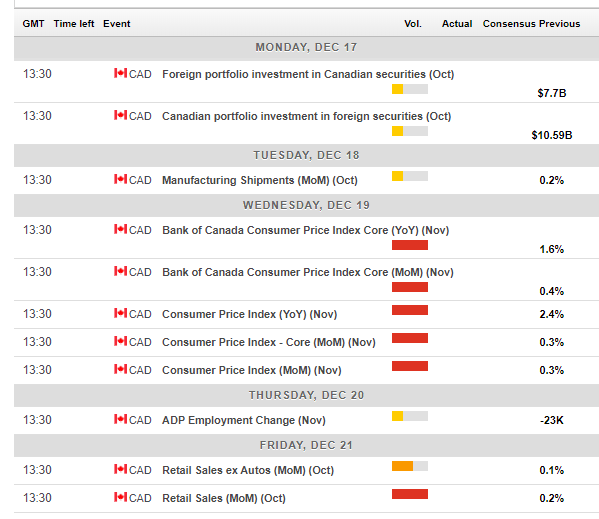- The loonie managed to recover, but oil and other concerns limited gains.
- A busy week features Canadian inflation and retail sales.
- The technical picture remains bullish for USD/CAD.
This was the week: Hopes on trade, oil not recovering
Trade relations took a decisive twist with China buying US soybeans and opening its ambitious 2025 to both involvements by foreign companies and also to modification. The US fears that China would gain a technological edge in future technologies such as Artificial Intelligence and robotics. The better market mood that followed helped the C$, a risk currency.
However, two former Canadian diplomats found themselves jailed in China, it what seems like a tit-for-tat reaction to the arrest of Huawei CFO Meng in Vancouver, upon a request from a US court. Her release on bail may help alleviate tensions. Fresh concerns about the strength of China’s economy emerged late in the week as industrial output, and retail sales decelerated. The resulting risk-off sentiment weighed on the Canadian Dollar.
Oil prices enjoyed only a temporary calm. Markets are now skeptical that the OPEC will fulfill its commitments to cut production and petrol prices were pressured once again, looming on the loonie.
A light Canadian calendar provided mixed data. Housing Starts surprised with 216K annualized while the New Home Price Index rose by 0.1% YoY, at a snail’s pace.
In the US, core inflation came out at 2.2% YoY, as expected.
Canadian events: Inflation and retail sales separately
The week kicks off with low-tier indicators: foreign investments and manufacturing shipments, which were both positive in September.
The primary publication is on Wednesday with the all-important inflation report. The Bank of Canada will be watching the report for November very carefully ahead of its January rate decision. Headline inflation rose by 2.4% YoY in October while Core CPI lagged with 1.6%. Any acceleration will raise the chances of a hike, which are substantially lower after the recent dovish comments.
The ADP NFP report is published on Thursday but tends to have a limited impact due to the release: after the official data is out.
A top-tier publication awaits on Friday. Retail sales hardly advanced in September, with the headline moving by 0.2% and core sales by a meager 0.1%. The data for October may be better. The report is usually released together with the inflation data but now has a chance to shine on its own.
Here is the Canadian calendar for this week:

US events: Almost only about the Fed
The central event of the week is the Federal Reserve’s decision. The world’s most powerful central bank will likely raise rates as they indicated clearly that this is their intention. However, signs of a slowdown and consequent dovish comments by Fed officials have cast doubts about interest rate hikes in 2019. The current dot-plot points to three increases next year, but the FOMC will likely downgrade the outlook, albeit not to current market expectations.
Apart from the dot-plot, the wording of the statement on the Fed’s mandates of employment and inflation, as well as on growth and other topics, will be of interest. Chair Jerome Powell will hold a press conference in which he could provide clarifications, and he will also answer questions.
Apart from Wednesday’s all-important decision, housing data on Tuesday and Wednesday are of interest as the sector has been lagging the rest of the economy in recent months.
Friday features a big bulk of figures. Q3 GDP growth will likely be confirmed at 3.5%, but changes in the composition of growth could make a difference. Durable Goods Orders for November are also of high interest as they provide investment data that the Jerome Powell follows closely. The central bank’s preferred gauge of inflation is also due on Friday. The Core PCE Price Index is expected to follow Core CPI and tick up to 1.9%.
All in all, the pre-Christmas week is hectic in the US.
Here are the critical American events from the forex calendar:

USD/CAD Technical Analysis
Dollar/CAD continued climbing alongside an uptrend channel. The dip below the line seen several weeks ago seemed to be a one-off. Another bullish sign is a rising Momentum. Moreover, the pair trades well above the 50-day and 200-day Simple Moving Averages.
Resistance awaits at 1.3420 which capped USD/CAD in mid-December. The 2018 high of 1.3445 is next. The next lines to watch are 1.3440 which was a stubborn cap in mid 217. 1.3640 and 1.3800 are next.
1.3380 was a temporary cap in mid-December and more importantly, a peak back in June. 1.3360 was a high point in late November and awaits closeby. 1.3320 was a resistance line in November and support in December. 1.3250 was a swing low in early December, and 1.3225 was a high point in September. Further down, 1.3160 was a swing low in November, and it is followed closely by 1.3135 which held the pair down in October.
USD/CAD Sentiment
A relatively hawkish Fed could send the “risk” Canadian Dollar lower. Also, the struggle for oil prices is unlikely to help. Canadian data will need to be extraordinary (something that did happen with the employment report), to push CAD higher. All in all, there are good prospects for a rise in USD/CAD.
The FXStreet forex poll of experts provides intriguing insights.
Related Forecasts
- USD/JPY Forecast: Can the optimism continue? Powell’s power play awaited
Get the 5 most predictable currency pairs

